Warranty Denial Letter
Subject: Warranty Denial Letter
Dear [Customer's Name],
We hope this letter finds you well. We appreciate your recent correspondence regarding your warranty claim for [product/model]. After careful review and assessment of the provided information, we regret to inform you that your warranty claim has been denied.
The decision to deny your claim was based on the following grounds:
1. [Reason for denial - e.g., Expiration of Warranty Period]: Our records indicate that the warranty period for your [product/model] expired on [date]. Unfortunately, your claim was submitted after the specified warranty coverage period, and we are unable to provide assistance beyond the warranty's expiration date.
2. [Reason for denial - e.g., Failure to Comply with Warranty Terms and Conditions]: Upon examination of your product, it was determined that the issues you encountered were a result of improper handling, misuse, or neglect. Our warranty explicitly states that it does not cover damages caused by user error or actions that are outside the scope of intended use.
3. [Reason for denial - e.g., Unauthorized Repairs or Modifications]: It has come to our attention that unauthorized repairs or modifications were made to your [product/model]. Any alterations or repairs performed by an unauthorized service provider can void the warranty, as stated in the terms and conditions.
We understand that this news may be disappointing, and we genuinely regret any inconvenience caused. However, we would like to remind you that our warranty policy is designed to protect against manufacturing defects and faults within a specified timeframe, ensuring the quality and performance of our products.
Please note that you have the option to seek assistance from an authorized service center or independent repair technician at your own expense. They may be able to diagnose the issue and provide suitable solutions outside the warranty coverage.
If you have any further questions or concerns regarding this matter, please do not hesitate to contact our customer service department at [phone number] or [email address]. We are committed to providing you with any additional information or clarification you may require.
Once again, we apologize for any inconvenience caused and thank you for your understanding.
Sincerely,
[Your Name]
[Your Title/Position]
[Company Name]
Product Defect Not Covered Under Warranty Terms
Subject: Warranty Claim Denial - Product Model [MODEL NUMBER]
Dear [Customer Name],
Thank you for contacting us regarding your warranty claim for [Product Name], purchased on [Purchase Date]. After thorough examination by our technical team, we must respectfully deny your warranty claim.
Our investigation reveals that the reported issue stems from [specific cause], which falls outside the coverage parameters outlined in your warranty agreement. Specifically, Section [X] of your warranty excludes damage resulting from [specific exclusion reason].
While we understand your disappointment, our warranty terms clearly state that coverage does not extend to issues arising from normal wear and tear, misuse, or environmental factors beyond our control.
We value your business and would be happy to discuss repair options at standard service rates. Please contact our customer service team at [phone number] to explore available solutions.
Sincerely,
[Name]
Warranty Claims Department
Warranty Period Expired
Subject: Warranty Claim Status - Coverage Period Expired
Dear [Customer Name],
We have received your warranty claim submission dated [Date] for your [Product Name], serial number [Serial Number].
After reviewing your purchase records, we find that your product was purchased on [Purchase Date], and the manufacturer's warranty expired on [Expiration Date]. Your current claim was submitted [X days/months] after the warranty coverage period concluded.
Unfortunately, we cannot process warranty claims for products beyond their coverage period, as outlined in the terms and conditions you received with your original purchase.
However, we offer extended service plans and out-of-warranty repair services. Our customer service team can provide you with a repair estimate and available options to restore your product to working condition.
We appreciate your understanding and continued loyalty to our brand.
Best regards,
[Name]
Customer Service Manager
Damage Due to Misuse or Neglect
Subject: Warranty Claim Denial - Product Misuse Identified
Dear [Customer Name],
Reference: Warranty Claim #[Claim Number]
Our certified technicians have completed a comprehensive evaluation of your [Product Name] submitted for warranty repair on [Date].
The examination reveals clear evidence of damage resulting from improper use, specifically: [detailed description of misuse]. This type of damage is explicitly excluded from warranty coverage under Section [X] of your warranty agreement.
Documentation and photographs of the damage have been retained in your service file. The warranty explicitly states that coverage is void when products are subjected to conditions outside normal operating parameters.
Your product will be returned to you in its current condition within 5-7 business days. Should you wish to pursue repairs at your own expense, please contact our paid repair services division.
Regards,
[Name]
Technical Services Department
Missing or Invalid Proof of Purchase
Subject: Warranty Claim Hold - Documentation Required
Dear [Customer Name],
We are currently reviewing your warranty claim for [Product Name], model [Model Number]. To process your claim, we require valid proof of purchase as specified in our warranty terms.
The documentation you provided does not meet our verification requirements because: [specific reason - illegible receipt, missing purchase date, unauthorized retailer, etc.].
To proceed with your warranty claim, please provide:
- Original receipt or invoice showing purchase date
- Authorized retailer documentation
- Product registration confirmation (if applicable)
Please submit the required documentation within 30 days of this notice. Claims without proper verification cannot be processed under our warranty policy.
We look forward to resolving your claim once proper documentation is received.
Thank you,
[Name]
Claims Verification Team
Third-Party Modification Voids Warranty
Subject: Warranty Void Notice - Unauthorized Modifications Detected
Dear [Customer Name],
Your warranty claim for [Product Name] has been reviewed and must be denied due to unauthorized modifications discovered during inspection.
Our technicians identified the following non-factory alterations:
- [Specific modification 1]
- [Specific modification 2]
- [Any additional modifications]
As clearly stated in your warranty agreement, any modifications, repairs, or alterations performed by unauthorized service providers immediately void all warranty coverage. This policy exists to ensure product safety and maintain quality standards.
The modified product will be returned to you unchanged. Please note that future service requests for this unit will be handled exclusively through our fee-based repair services.
If you have questions about this determination, please contact our technical review board within 15 days.
Respectfully,
[Name]
Warranty Review Committee
Commercial Use of Consumer Product
Subject: Warranty Claim Update - Commercial Use Exclusion
Hi [Customer Name],
Thanks for reaching out about your [Product Name]. We've looked into your warranty claim and unfortunately, we won't be able to cover the repair costs.
Here's the situation: our records show this product has been used in a commercial setting, but it was sold as a consumer-grade item with a residential warranty. Commercial use puts much more stress on products than typical home use, which is why we have separate product lines and warranties for business applications.
Your warranty specifically excludes commercial, industrial, or business use - it's mentioned in the fine print of your agreement.
While we can't cover this under warranty, our commercial service team can definitely help you out with repair options. They deal with heavy-use situations all the time and can get you back up and running.
Give us a call at [phone number] and mention you need commercial service support.
Thanks for understanding!
[Name]
Customer Care Team
Environmental Damage Exclusion
Subject: Warranty Claim Resolution - Environmental Damage
Dear [Customer Name],
I want to personally address your warranty claim for the [Product Name] that was damaged during the recent [flood/storm/fire/etc.] in your area. First, let me say how sorry I am that you're dealing with this situation.
After careful evaluation, our technical team has determined that the damage to your product resulted from environmental factors beyond normal operating conditions. Unfortunately, our warranty coverage specifically excludes damage from natural disasters, flooding, extreme temperatures, and similar environmental causes.
I know this isn't the news you were hoping for, especially after everything you've been through. While we can't cover this under warranty, I want to make sure you know about our disaster relief program. We offer significant discounts on replacement products for customers affected by natural disasters.
Please contact our disaster relief coordinator at [phone number] within 60 days. They can explain the available options and help you get back on your feet with minimal expense.
Our thoughts are with you during this difficult time.
Warmly,
[Name]
Customer Relations Manager
What is a Warranty Denial Letter and Why is it Necessary
A warranty denial letter is a formal communication from a manufacturer, retailer, or service provider to a customer explaining why their warranty claim cannot be honored. These letters serve multiple critical purposes: they provide legal documentation of the decision, maintain transparency in customer relationships, explain specific reasons for denial, protect company interests, and offer alternative solutions when possible. The letter creates a paper trail that protects both the company and customer while maintaining professional standards even in disappointing situations.
When to Send Warranty Denial Letters
Warranty denial letters should be sent in the following scenarios:
- Product is beyond the warranty coverage period
- Damage resulted from customer misuse or neglect
- Product was modified by unauthorized service providers
- Environmental or accidental damage occurred
- Missing or insufficient proof of purchase
- Commercial use of consumer-grade products
- Damage from normal wear and tear
- Product was purchased from unauthorized dealers
- Warranty registration was never completed
- Damage from power surges or electrical issues
- Customer attempted self-repair
- Product was subjected to extreme conditions
Who Should Send These Letters
Warranty denial letters should be sent by authorized company representatives including:
- Customer service managers
- Warranty claims departments
- Technical service teams
- Quality assurance personnel
- Customer relations specialists
- Regional service managers
- Authorized dealer representatives
The sender should have proper authority to make warranty decisions and access to customer records, technical evaluation reports, and company warranty policies.
Requirements and Prerequisites Before Sending
Before sending a warranty denial letter, ensure you have:
- Completed thorough product inspection
- Documented all findings with photos or reports
- Reviewed customer purchase history
- Verified warranty terms and conditions
- Consulted with technical experts if needed
- Checked for any applicable exceptions or policies
- Gathered all relevant documentation
- Confirmed customer contact information
- Reviewed company escalation procedures
- Prepared alternative solution options
Essential Elements and Structure
Every warranty denial letter must include:
- Clear subject line referencing the claim
- Customer's full name and contact information
- Product details (model, serial number, purchase date)
- Specific reason for denial with policy reference
- Explanation of evaluation process
- Alternative options or next steps
- Professional closing with contact information
- Timeline for any required customer action
- Reference to appeal processes if available
- Company signature and title
Proper Formatting and Tone Guidelines
Maintain these formatting standards:
- Use professional business letter format
- Keep length between 200-400 words
- Choose appropriate tone based on situation (empathetic for disasters, firm for misuse)
- Include clear headers and spacing
- Use bullet points for multiple issues
- Avoid technical jargon
- Maintain respectful language throughout
- Include proper company branding
- Ensure mobile-friendly format for emails
- Use active voice and clear statements
Common Mistakes to Avoid
Avoid these critical errors:
- Being vague about denial reasons
- Using overly technical language
- Failing to reference specific warranty terms
- Forgetting to offer alternative solutions
- Not documenting the decision properly
- Sending without proper authorization
- Using inappropriate tone for the situation
- Missing customer contact information
- Failing to set clear timelines
- Not providing appeal options
- Overlooking company policy exceptions
- Sending without thorough investigation
Follow-up Actions After Sending
After sending a warranty denial letter:
- Update customer service records
- File documentation in customer account
- Set reminder for any promised follow-ups
- Monitor for customer responses or appeals
- Prepare for potential escalation
- Track letter delivery confirmation
- Follow up on any alternative solutions offered
- Document any additional customer communications
- Review case if new information emerges
- Ensure proper case closure procedures
Advantages and Disadvantages of Warranty Denial Letters
Advantages:
- Creates legal protection for the company
- Maintains transparency with customers
- Provides clear documentation trail
- Offers opportunity to suggest alternatives
- Demonstrates professional customer service
- Protects warranty program integrity
Disadvantages:
- May damage customer relationships
- Can lead to negative reviews or publicity
- Might result in customer churn
- Could trigger legal challenges
- May require time-consuming follow-up
- Can create internal administrative burden
Expert Tips and Best Practices
- Always investigate thoroughly before deciding
- Use empathetic language when appropriate
- Reference specific warranty clauses
- Offer alternative solutions when possible
- Respond promptly to maintain trust
- Keep detailed records of all decisions
- Train staff on consistent messaging
- Regular review of denial patterns
- Consider customer lifetime value
- Provide clear appeal processes
- Use templates for consistency
- Personalize messages when feasible
- Follow up on promised actions
- Monitor customer feedback closely

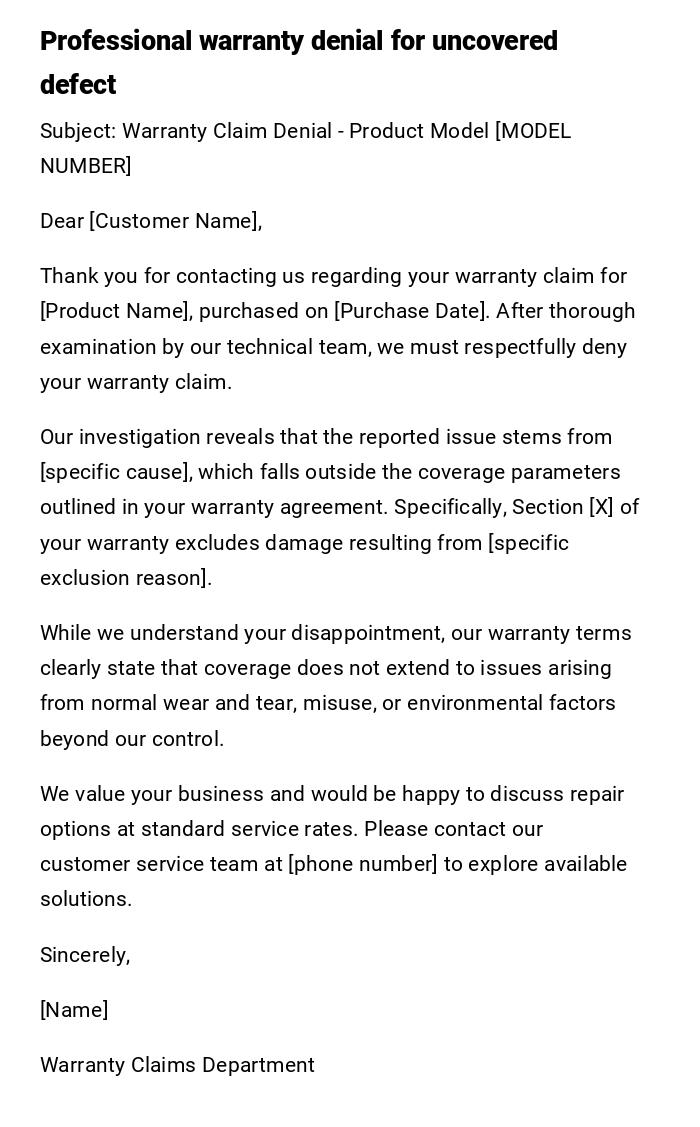
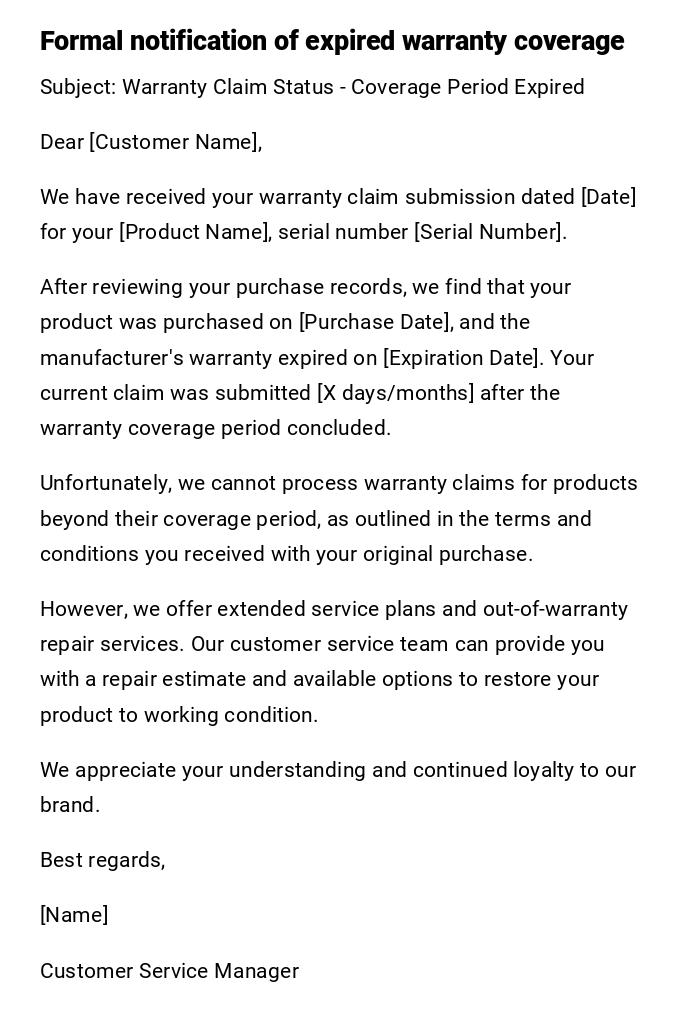
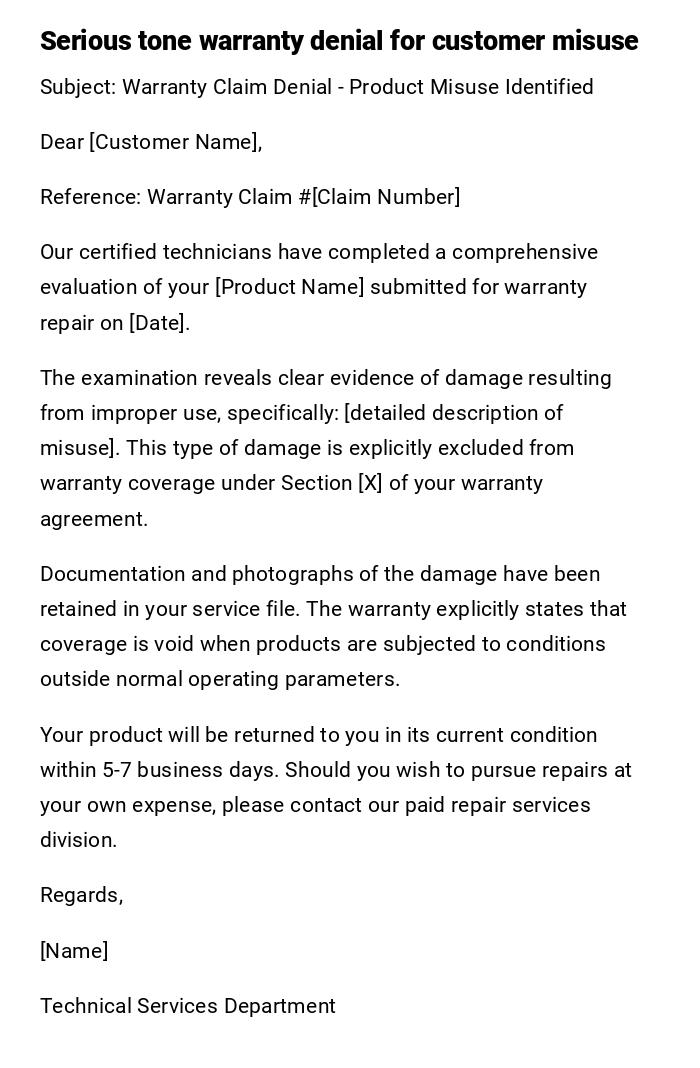
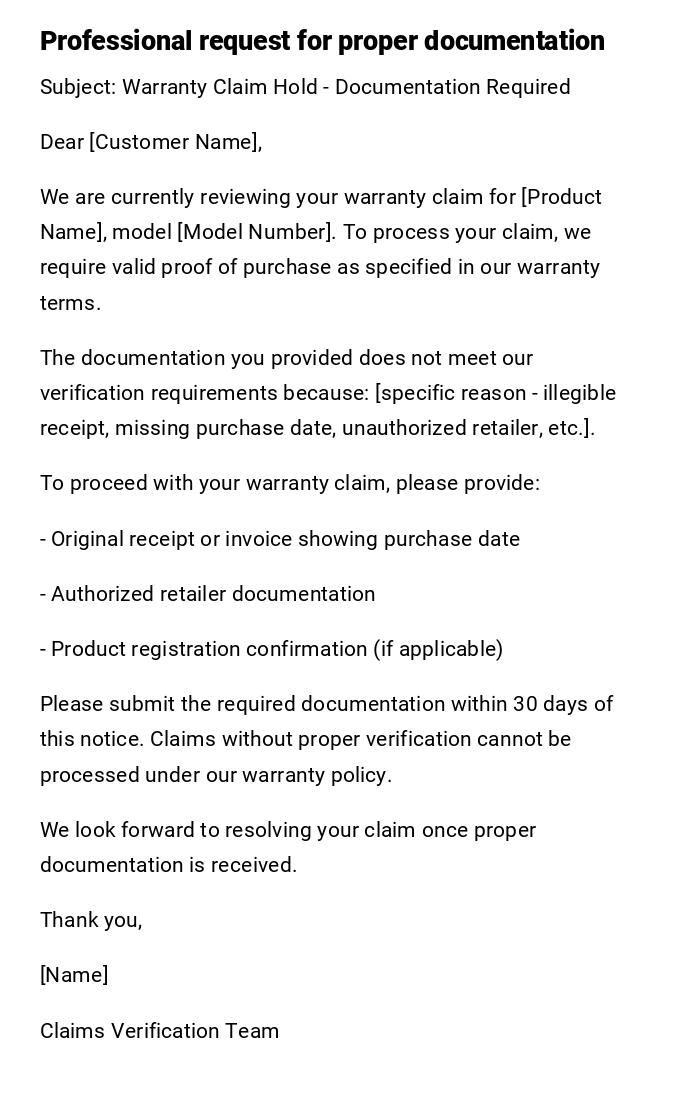
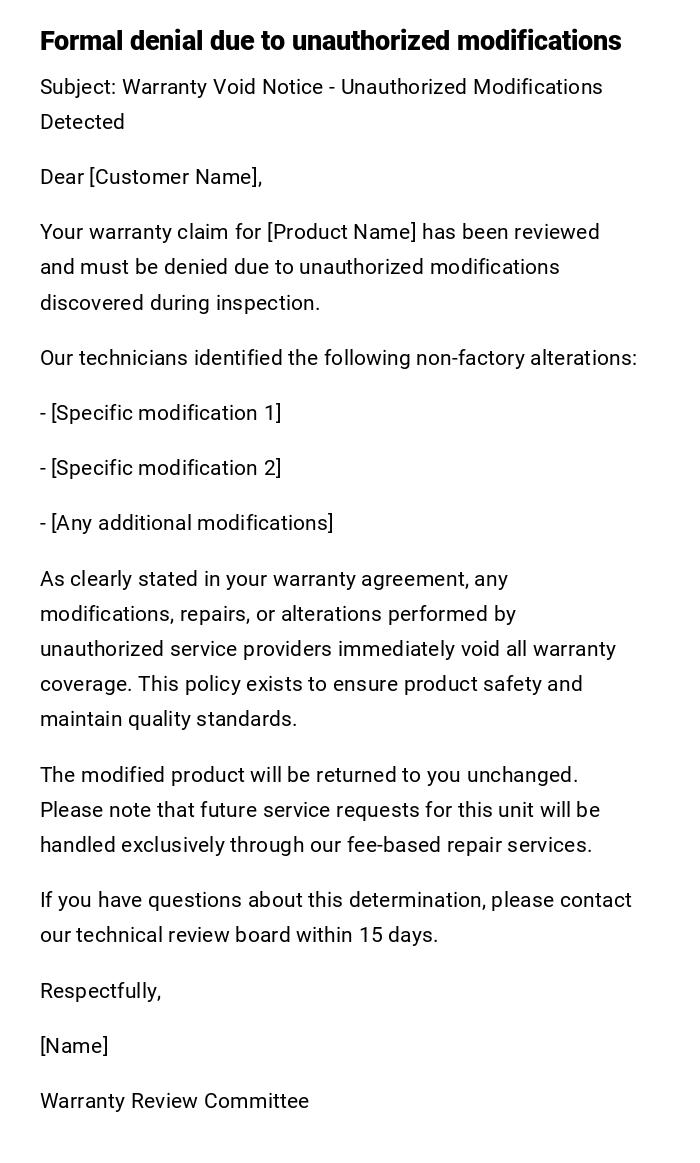
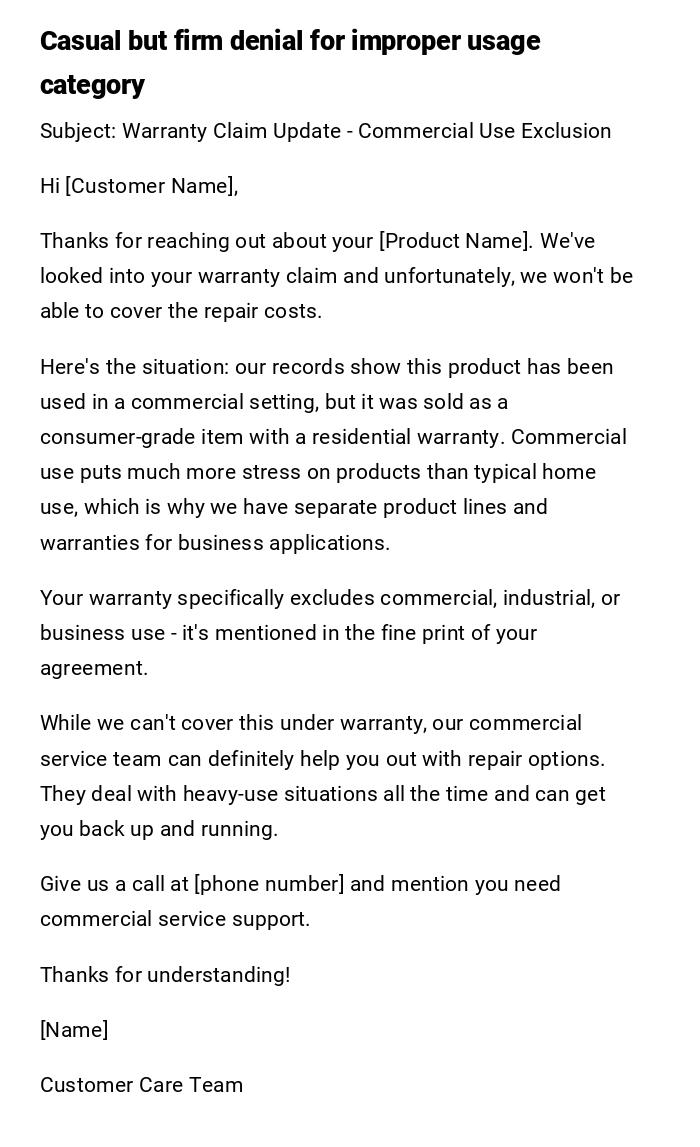
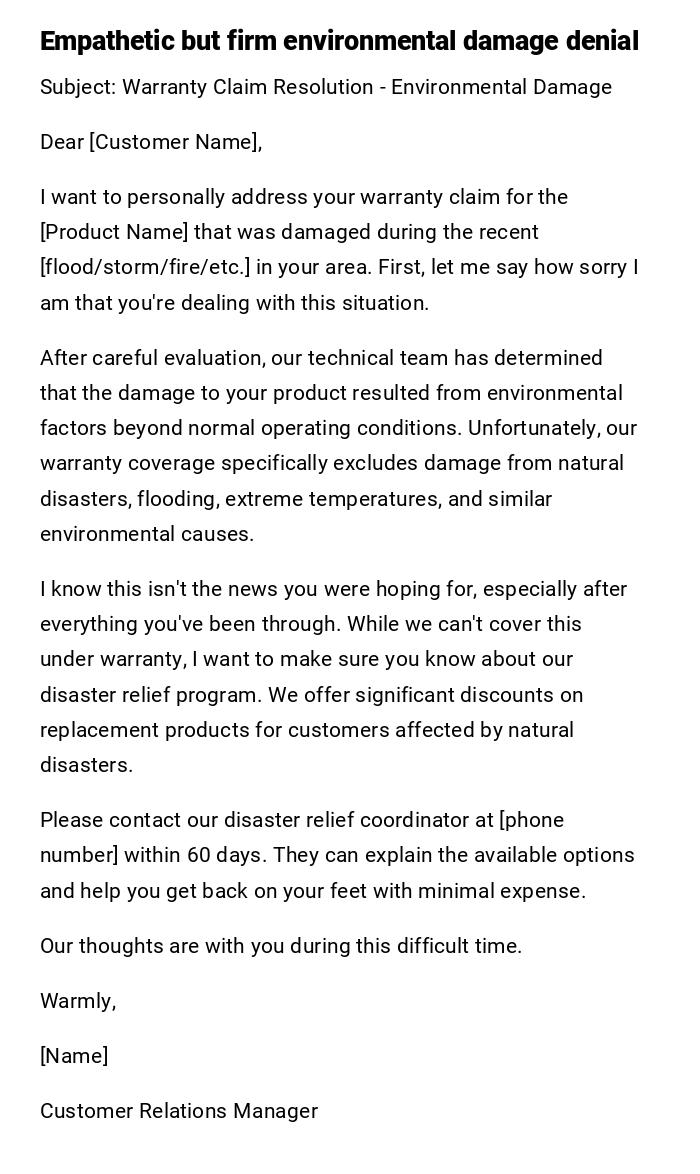

 Download Word Doc
Download Word Doc
 Download PDF
Download PDF